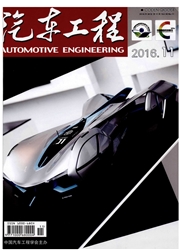

 中文摘要:
中文摘要:
在一台满足国III排放法规的多点电喷汽油机上,分别使用傅里叶红外光谱仪( FTIR)(在线)、气相色谱仪和液相色谱仪(离线),对同一工况和相同燃料条件下的甲醛排放物进行检测和对比。结果表明:FTIR检测的发动机尾气中甲醛排放规律与气相和液相色谱仪检测出的规律一致,但FTIR法的检测值要比色谱法高。另外,使用FTIR测量了常规车用三效催化转化器前后的甲醛、乙醛、甲醇等非法规排放,结果表明:随着掺醇比例的增加,甲醛和甲醇排放急剧增加,乙醛排放则减少。三效催化转化器对甲醇汽油掺混燃料的甲醛、乙醛和甲醇排放转化效果显著,经处理后,基本上可实现零排放。
 英文摘要:
英文摘要:
Fourier transform infrared spectroscopy (FTIR) (on-line), gas chromatography (GC) and liq-uid chromatography ( LC) ( off-line) are used respectively to detect and compare the formaldehyde pollutants from an electronic gasoline multi-point injection engine, meeting State-III emission regulations with same fuel at same working conditions. The results show that the law of formaldehyde emission in engine tail gas detected by FTIR is basically consistent with that by GC and LC, but the value of formaldehyde emission detected by FTIR is higher than that by chromatography. In addition, unregulated emissions including that of formaldehyde, acetaldehyde and methanol before and after conventional three-way catalytic converter ( TWC) are also measured by FTIR with a result indicating that with the increase in the proportion of methanol in blend fuel, the emissions of formaldehyde and methanol rise substantially while the emission of acetaldehyde reduces. The conversion effects of TWC on formaldehyde, acetaldehyde and methanol emissions for methanolgasoline blend fuel are significant, and zero emission can basically be achieved after treatment.
 同期刊论文项目
同期刊论文项目
 同项目期刊论文
同项目期刊论文
 Experimental investigation on regulated and unregulated emissions of a diesel/methanol compound comb
Experimental investigation on regulated and unregulated emissions of a diesel/methanol compound comb Experimental and Computational Studies on Ignition Characteristics of Diesel in a Premixed Ethanol-A
Experimental and Computational Studies on Ignition Characteristics of Diesel in a Premixed Ethanol-A Simulations of diesel-methanol dual-fuel engine combustion with large eddy simulation and Reynolds-a
Simulations of diesel-methanol dual-fuel engine combustion with large eddy simulation and Reynolds-a Experimental and modelling studies of the effects of methanol and ethanol addition on the laminar pr
Experimental and modelling studies of the effects of methanol and ethanol addition on the laminar pr Experimental and modeling study of the effect of ethanol and MTBE on the oxidation of PRF90 in low p
Experimental and modeling study of the effect of ethanol and MTBE on the oxidation of PRF90 in low p 期刊信息
期刊信息
